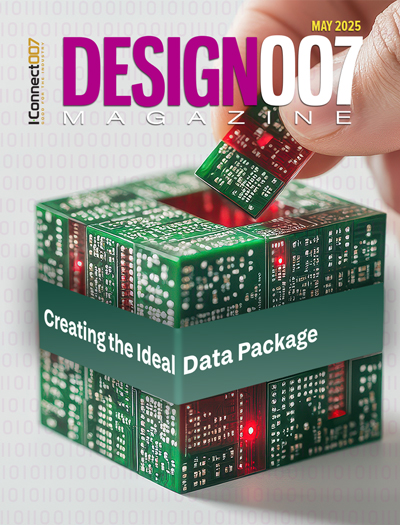-

- News
- Books
Featured Books
- design007 Magazine
Latest Issues
Current Issue
Creating the Ideal Data Package
Why is it so difficult to create the ideal data package? Many of these simple errors can be alleviated by paying attention to detail—and knowing what issues to look out for. So, this month, our experts weigh in on the best practices for creating the ideal design data package for your design.

Designing Through the Noise
Our experts discuss the constantly evolving world of RF design, including the many tradeoffs, material considerations, and design tips and techniques that designers and design engineers need to know to succeed in this high-frequency realm.

Learning to Speak ‘Fab’
Our expert contributors clear up many of the miscommunication problems between PCB designers and their fab and assembly stakeholders. As you will see, a little extra planning early in the design cycle can go a long way toward maintaining open lines of communication with the fab and assembly folks.
- Articles
- Columns
Search Console
- Links
- Media kit
||| MENU - design007 Magazine
Shrinking Geometries: Back to Fundamentals to Fight EMI
February 23, 2023 | Andy Shaughnessy, Design007 MagazineEstimated reading time: 1 minute
When silicon shrinks, a variety of things can happen—some positive, some negative. But for PCB designers, the fight against EMI becomes more complex as signal channels shrink and rise times increase.
Dan Beeker is technical director at NXP Semiconductors, a veteran design engineer, and an instructor who has spent years helping students and customers battle EMI through building a better understanding of electromagnetic fields and field theory. In this interview, Dan explains what happens when silicon shrinks, how feature size controls signal speed, and why this marks the perfect time to return to the fundamentals of physics and field theory.
Andy Shaughnessy: Shrinking silicon is increasingly causing EMI issues for PCB designers and EEs. What sort of problems does shrinking silicon cause?
Dan Beeker: Smaller device geometries and higher current switching capabilities have thrust us all into the world of RF, HF, UHF, and microwave energy management. Rise times on even the lowest-tech devices now exhibit gigahertz impact. These changes directly impact product functionality and reliability. When IC technology was described as a percent of shrink from integer design rules, a circuit-based approach was usually close enough. Now that IC technology is described in nanometers, that traditional approach completely falls apart. An EM field, physics-based approach is essential.
To make things worse, EMC standards have changed; we now have lower and higher frequency compliance requirements, much lower emissions levels allowed, and greater immunity required. The playing field and the equipment have completely changed. This really is a brand-new game. The challenges are not only about providing adequate power to the devices, but also managing the output signals. The smaller the transistor, the faster it turns on, and the bigger the impact it has on EMC and signal integrity.
To read this entire interview, which appeared in the February 2023 issue of Design007 Magazine, click here.
Suggested Items
Tips to Master the ‘Black Magic’ of RF Design
05/01/2025 | Andy Shaughnessy, Design007For this issue on RF design, I reached out to Zach Peterson, founder of Northwest Engineering Solutions, an engineering design services company in Portland, Oregon. You can find some of Zach’s RF design presentations on YouTube; he does a great job breaking down these complex ideas for PCB designers who are new to the RF side of things. I asked Zach to discuss the challenges facing RF designers, the relevant material considerations, and the layout tips and techniques that can help RF designers master this “black magic” technology.
The EEcosystem and Dr. Eric Bogatin Launch Free Masterclass for Electronics Engineers
05/01/2025 | The EEcosystemThe EEcosystem, a podcast media and education brand serving professional electronics engineers, is proud to announce the launch of a new online learning platform: The EEcosystem Electronics Masterclass. The platform debuts with Transmission Lines 101, a free course created in partnership with world-renowned signal integrity expert Dr. Eric Bogatin. The course will be available starting May 1, 2025.
NEXT Semiconductor Technologies Collaborates with BAE Systems to Develop Next Generation Space-Qualified Chips
04/28/2025 | PRNewswireNEXT Semiconductor Technologies is collaborating with BAE Systems to accelerate the insertion of its latest ultra-wideband antenna processor units (APUs) into high-performing radiation-hardened electronic subsystems to support future space missions.
Elementary Mr. Watson: Navigating RF—A Glide Path Approach to Design Success
04/24/2025 | John Watson -- Column: Elementary, Mr. WatsonOn a flight, I can always tell when we begin our descent because that subtle drop in my stomach tells me the altitude has changed. Landing an airplane involves a gradual, precise process called the glide path. It descends at the correct speed and 3-degree angle to touch down smoothly and safely on the runway without bouncing or coming to a sudden stop. Pilots use specialized tools like the Instrument Landing System (ILS) or GPS to stay on the correct path. Lights on the ground, called PAPI lights, help pilots know if they are too high or too low.
Designers Notebook: Layer Stackup Planning for RF Circuit Boards
04/17/2025 | Vern Solberg -- Column: Designer's NotebookWhen designing multiple layer circuits requiring impedance control, the circuit board designer will work closely with an engineering specialist cognizant of RF printed circuit board design and layout, including mixed-signal applications.


